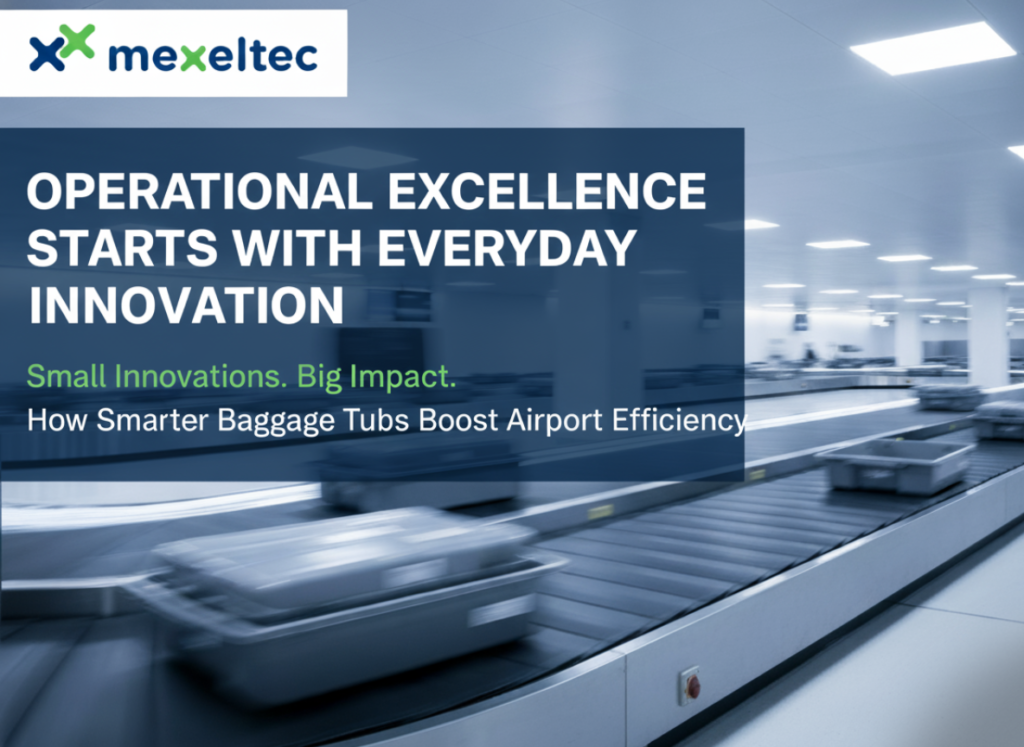How Material Handling Solutions Improve Efficiency in Airports & Logistics Hubs
How Material Handling Solutions Improve Efficiency in Airports & Logistics HubsIf you look closely at the busiest airports or logistics hubs in the world, you will notice something interesting. The ground looks calm. Bags move. Parcels flow. Conveyors hum. Passengers glide through. Trucks load faster. Warehouses stay organised. Every system looks predictable and controlled.But behind this “effortless” movement lies a powerful ecosystem: material handling solutions—the backbone of every operationally strong airport and logistics hub.Most people think material handling solutions are just conveyors, tubs, or counters. But in reality?They are productivity multipliers.They are time savers.And they are profit boosters.In this guide, you’ll discover exactly how material handling solutions improve efficiency in airports and logistics hubs, why the biggest global brands invest heavily in them, and what you should prioritise when choosing the right partner. 1. The Real Meaning of Material Handling Solutions (and Why It Matters)Before we jump into efficiency gains, let’s get one thing straight.Material handling solutions are not individual machines—they are systems.A system designed to:Move materials safelyReduce operational wasteImprove speedIncrease accuracyMake processes predictableReduce manual labourEliminate bottlenecksIncrease throughputThink about any airport. Nothing there is random.Every movement—bags, cargo, trays, trolleys, and people—is controlled by a carefully engineered material handling system.At logistics hubs and warehouses, the same story repeats.Whether it’s:Shipping parcelsSorting goodsUnloading trucksLoading palletsMoving products to storageDispatching orders…everything relies on the strength of the underlying material handling solutions. 2. Why Airports Can’t Function Without Material Handling SolutionsAirports operate under tremendous pressure.Every minute counts. Every delay costs money. Every mistake causes operational chaos.Without strong material handling systems, airports face:Passenger dissatisfactionLost baggage incidentsCongested checkpointsSlow baggage deliverySecurity risksDelayed aircraft turnaroundThis is why airports invest in multiple components of the material-handling ecosystem, such as:✔ Belt ConveyorsFor fast and smooth baggage movement.✔ Roller ConveyorsFor manual inspection zones and load transfers.✔ Baggage TubsTo protect passenger luggage during scanning and handling.✔ Airport Check-In CountersTo create organised, fast-moving passenger flow.✔ Security Screening SystemsX-rays, metal detectors, and tray return systems.✔ Sorting SystemsTo ensure each bag reaches the right aircraft.Together, these become the invisible “blood vessels” of every busy airport.3. How Material Handling Solutions Make Logistics Hubs More EfficientLogistics hubs have one primary objective:Move goods faster with fewer errors.Unlike airports, logistics hubs deal with total volume and speed of delivery.If they fail at this, everything collapses:Delayed shipmentsCustomer complaintsReturns and refundsLow warehouse productivityIncreased labour costBreakdowns in the supply chainMaterial handling solutions solve all these problems with:✔ Automated Conveyor SystemsFor seamless, uninterrupted parcel movement.✔ Sorting ConveyorsTo streamline distribution by size, weight, or destination.✔ Loading & Unloading ConveyorsEspecially truck loading conveyors—the highest ROI system in logistics.✔ Pallet Handling SystemsTo automate warehouse storage and retrieval.✔ Carton Flow SystemsTo speed up picking and replenishment.The result?Faster order fulfilment. Better accuracy. Lower cost per shipment. Reduced manual handling. Higher throughput.4. The ROI of Investing in Material Handling SolutionsBusinesses don’t invest in material handling systems just because they “look modern.” They do it because the returns are massive.Here’s how material handling solutions deliver ROI:1. Speed — Faster OperationsConveyors don’t take breaks. They don’t get tired. They run 24/7 and move items faster than humans.2. Cost Savings — Reduced Manual LabourLess manpower = fewer injuries + lower salaries + fewer errors.3. Accuracy — Zero GuessworkAutomation removes the randomness of human decisions.4. Space EfficiencyBetter systems → more use of vertical and horizontal space.5. Reduced DamageMaterial moves smoothly, safely, and consistently.6. Better ThroughputWhen everything flows like clockwork, total output increases.This is why top airports and logistics hubs across the world adopt strong material handling solutions early—they understand the compounding effect.5. The Most Important Material Handling Systems for AirportsLet’s break this down into airport-specific components:✔ Airport Conveyors (Belt & Roller)These move:Check-in baggageSecurity traysTransit luggageOversized itemsStrong conveyors reduce waiting time and improve aircraft turnaround.✔ Baggage TubsThese protect fragile and small items inside x-ray machines and transport belts.✔ Airport Check-In CountersA professionally designed counter can handle:High passenger volumesFaster transactionsSmoother queue management✔ Baggage Handling SystemsThis includes:SortingTaggingLoadingUnloadingTransfer operations✔ Security Checkpoint ConveyorsFor trays and passenger belongings.Together, these systems determine the overall airport experience.6. The Most Important Material Handling Systems for Logistics HubsNow let’s talk logistics hubs—these rely heavily on engineered systems that increase total volume.✔ Truck Loading ConveyorsThese reduce loading/unloading time by more than 50%.✔ Sorting ConveyorsFor rapid parcel classification.✔ Powered & Gravity Roller ConveyorsIdeal for manual zones.✔ Belt ConveyorsFor long-distance transport within facilities.✔ Pallet Conveying & Racking SystemsHelps with systematic storage.✔ Scanning & Labelling IntegrationMakes order processing predictable.These systems transform manual warehouses into high-performance distribution machines.7. 10 Ways Material Handling Solutions Improve EfficiencyTo summarise the real performance gains:Faster baggage or parcel movementReduced human errorHigher throughputShorter turnaround timeBetter safetyControlled traffic flowReduced labour dependencyMinimal product damageHigher storage utilisationPredictable daily operations8. Why Choosing the Right Material Handling Partner MattersYou can buy machines from anywhere.But material handling solutions? You need expertise, engineering knowledge, and installation accuracy.A wrong calculation = breakdown costs A wrong alignment = unsafe movement A wrong design = low throughput Wrong installation = continuous maintenance issuesThis is where Mexeltec stands out.9. Why Mexeltec?Mexeltec offers complete material handling solutions for:IndustriesAirportsWarehousesLogistics centresIncluding:Roller conveyorsBelt conveyorsAirport countersBaggage tubsBaggage handling systemsAirport conveyor installationEnd-to-end design, supply & commissioningYour advantage?✔ In-house design expertise ✔ Custom manufacturing ✔ High-quality engineering ✔ On-site installation & testing ✔ Long-term supportIf you want your airport or logistics hub to run faster, smoother, and more efficiently, you need a partner who understands the system—not just the machine. Final ThoughtsEfficiency in airports and logistics hubs is not created by chance. It is engineered.And the biggest driver behind that efficiency is powerful, well-designed material handling solutions that work 24/7 to keep your operations flowing.If your goal is:Higher productivityFaster movementLower operational costImproved passenger or customer experience…then it’s time to invest in upgraded material handling systems.Mexeltec is ready to design, supply, install, and commission the systems you need.
How Material Handling Solutions Improve Efficiency in Airports & Logistics Hubs Read Post »
